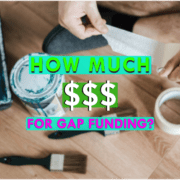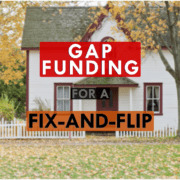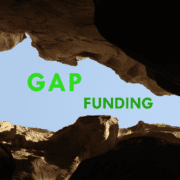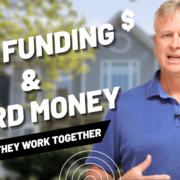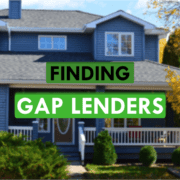How do gap funding and hard money go together?
As we move toward a recession, your money as a real estate investor will tighten. Lenders who used to give you 90% of the value of a property will now only offer 80% or less.
Where will you come up with that extra 20% or more? Is real estate in a recession only for those of us with hundreds of thousands of dollars sitting around?
Not at all. Lenders tightening only means that gap funding will become more important for real estate investors.
Let’s look at what gap funding is, how to apply it to your upcoming purchases, and how it integrates with a hard money loan.
What Is Gap Funding?
What does “gap funding” mean in the real estate world?
Gap Funding Definition
Gap funding is the money you bring in from another source to fill any gap left between the lender and the project costs.
If a lender offers you 70% of the LTV on a property, gap funding is how you fill in the remaining 30%. Usually gap funding is secured, although unsecured gap funding is possible.
A “secured” loan means that the debt is backed by a piece of collateral. In a typical gap funding scenario, the loan is secured by the property being purchased.
For the most part, you won’t be able to find a gap lender at an institution like you can a bank lender. Instead, gap lenders are family members, friends, or someone you know.
OPM vs Gap Funding
You can use a couple gap funding terms interchangeably:
- gap funding
- gap lending
- OPM (other people’s money)
- real people’s money
All of these terms get at the same concept. It’s money, not from you and not from an institutional lender, that covers whatever costs of an investment property that your lender won’t fund.
OPM can cover up to 100% of a deal, but for now, we’ll be talking about it in a strictly gap funding sense. These are loans that fill in the holes of a project that a mortgage or hard money loan wouldn’t cover.
Gap Funding for Flips
During a time when lenders are offering less money up-front for investment deals, you might need more money to fill in the gaps on your fix-and-flip projects.
Here are a few phases where you might need gap funding on your project.
Down Payments
Hard money lenders require at least 10% as a down payment. This is a very common use for gap funding.
If you use gap funding for your down payment, you’ll need to find out right away whether or not your hard money lender will accept a secured gap loan on the property.
Construction Costs
Another way to use gap funding for flips is for construction costs – rehab, repair, or anything necessary to bring the house up to the ARV and onto the market. These expenses can rack up fast, and they may not be completely covered by the main loan for the flip.
Carry Costs
Some investors will only use gap funding for the carry costs during their flip.
The lender will pay the mortgage payment, the insurance, or whatever other monthly costs are required during the project. Having a gap lender for carry costs can smooth out a fix-and-flip experience.
The Reach of Gap Funding for Fix-and-Flips
It’s possible to coordinate with your gap lenders to cover all three of these additional costs. This is a common way investors successfully finish fix-and-flips with zero money down.
You can use gap funding however you need, as long as both the hard money lender and the gap lender agree that the loan fits their criteria.
Not all hard money lenders allow you to secure your gap loan with a lien on the property you’re closing on. And not all gap lenders will loan to you unsecured.
Gap Funding for BRRRR
Gap funding is also used for BRRRRs, and works much like fix-and-flips. The biggest differences happen at closing.
Gap Funding Process During BRRRRs
BRRRR gap funding can be used the same way as a fix and flip: down payment, construction, or carry costs.
For BRRRR though, you need to close the gap funding loan on the same day as closing. You’ll also need to be sure you close the gap funding at the title company, with your lender. So you’ll need to know in advance that your hard money lender allows gap funding with a lien on the property.
Protecting Your BRRRR Refinance While Using Gap Funding
If you close your gap loan too late or incorrectly, your long-term lender can consider your refinance cash-out, not rate-and-term. This will lower the LTV on your refinance.
It’s important to get the money for your loan back in the refinance. In a good BRRRR transaction, you walk away with a house that’s cash-flowing and little to no money out of your pocket.
How to Calculate Gap Funding
How do you calculate what you’ll need for gap funding? It depends on each project.
Calculating Gap Funding Needed for a Project
The way to figure out the gaps in your project is simple:
(Cost of Property + Rehab Costs) – Hard Money Loan Amount = Gap Funding Amount Needed
If the property costs $200,000, but your lender gives $140,000, there’s a $60,000 gap you’ll need to cover. You can:
- Pay the $60,000 out-of-pocket
Or
- Bring in a gap lender, enabling you to buy the property with 100% financing. You would likely use part of this loan for the down payment and part for construction costs.
How to Calculate Construction Costs
Most hard money lenders use the ARV (anticipated retail value) rather than LTV (loan in relation to the current sale value).
In case your loan is for LTV only and doesn’t take into account construction costs, here’s how you would calculate those costs for an undermarket home:
ARV – Actual Cost of Property = Maximum Construction Budget
It’s important for you to work these numbers and know your budget up-front. Keep in mind, it’s always better to err on the generous side with your numbers. You want to be sure you can get done on-time and within the budget allotted by your hard money and gap lenders.
Ways to Secure a Gap Loan
So when you hear the advice to “secure” your gap loan, what does that mean? How do you secure a gap loan? And why?
Securing with Two Lenders
Securing your loan involves both your hard money lender and your gap lender.
Your friend or family member is giving you a fairly large chunk of money. They’ll want to know how you’ll secure it for them.
Securing your gap lender’s loan involves putting a lien on the property. Does your hard money lender allow this? Not all lenders will.
If Your Hard Money Lender Doesn’t Allow a Lien
If your hard money lender does not allow a lien on the property, you’ll have to secure the loan with a different property.
You could either put the lien on your own home, or you could use another rental or investment property.
If They Do Allow a Lien
If your hard money lender does allow a lien on the property to secure a gap loan, it’s best to do during closing with the mortgage and deed. This way title records it, and you have evidence for your gap funder that it’s recorded.
Many gap lenders – especially if they’re family or friends – won’t be educated enough about the real estate world to understand how to secure their money. As the investor, it’s your responsibility to keep your lenders’ money safe.
Securing the Loan
No matter which property has the lien, you’ll have to take a few important steps to secure the gap loan.
You’ll need a note – a promissory note between you and your gap lender – and a lien, either a mortgage or a deed of trust. And you’ll have to record all this with the county.
To make sure the loan is concerned, be sure to check all these boxes. It’s important to do this thoroughly so your lender will:
- Get their money back
- Feel comfortable with the deal
- Want to lend to you again
- Recommend you to their network
For More Help on Gap Funding and Hard Money
Gap funding and hard money are big, important concepts that work together for real estate investors.
If you’re left with questions, you can reach out to us at info@hardmoneymike.com, on Facebook, or at HardMoneyMike.com.
We’re more than happy to answer specific questions on specific deals.
You can also check out these videos on gap funding and OPM.
Happy Investing.





